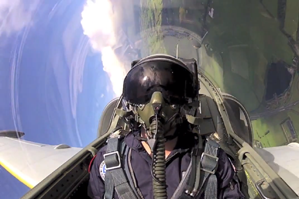Prepare for takeoff

A little over a year ago, Justin Dowd’s boss bought a pack of colored chalk to write the day’s specials on the wall. Little did he know, that chalk would change Dowd’s life forever. The Northeastern undergraduate, then a third-year studying physics, told me he’d always had a penchant for doodling and a minor love affair with Einstein’s theory of relativity. After getting creative with the chalk menu and gaining some skills with the dusty medium, Dowd decided to make what he calls a “chalkimation” video explaining relativity.
He spent two months holed up in his basement and at the end submitted the final product to the Metro Newspaper’s Space Race. A few months later he was juggling phone calls from journalists, astronauts, and elected officials: a year ago today, Justin Dowd learned he’d be taking a trip to space, all thanks to the chalk drawings.
Since then, Dowd has been fairly busy. In addition to continuing his studies in the physics department, he’s been hobnobbing at space parties in Manhattan and taking trips to the Netherlands to experience weightlessness and acceleration forces that made him feel three times heavier than he is. He’s seen the world through the window of an F16 jet and he’s sat inside a space simulator the size of a house.
On the first day of his training, Dowd climbed into the simulator and watched the doors close around him. He was completely enclosed, staring at a computer screen, as the instrument began to spin. But it didn’t feel like spinning, he said. Instead, since he had no orientation other than the screen, which showed him barreling straight down a runway, it gave the illusion of accelerating forward.
“The acceleration was incredible,” he said. “It was like getting vacuumed into the seat. You can literally feel your skin getting pulled back and it was just a raw power like I’ve never felt before.”
And this was just the acceleration period. At it’s fastest point, just before reentering the atmosphere, the rocket will be traveling three times the speed of sound, he said. In order to slow down, it performs a 20 degree bank turn, yielding the most intense force of the trip at four to five times the force of gravity (4-5Gs). At just 3.5 Gs, the greatest force possible in the simulator, Dowd’s blood rushed toward his feet and the trainers told him to tense his muscles to force the blood back into his head so he wouldn’t faint.
The next day, in the F16, Dowd experienced 5Gs. And then he felt himself go weightless. With the jet pointing straight upward, the pilot pulled back on the stick so they began to fly in an upward arc. The jet, the pilot, and Dowd were floating in the air. “It’s true, genuine weightlessness,” he said. He told me it felt like being inside a warm pool with all of his muscles completely relaxed and having no orientation towards up or down, left or right.
The whole experience made Dowd want to take up flying. So now he’s not only a freelance chalkimation artist, he’s also taking flight lessons. This year has completely changed his perspective, he said, and perhaps also the trajectory of his own life. He’s considering going into the private space industry when he graduates.
Dowd’s next training mission will be in the fall when he’ll hop into a hollowed out passenger plane to do nose dives over the Gulf of Mexico. The plane will be falling, and so will everyone else in it, he said. They’ll do this forty times at 30 seconds each. “That’s gonna be twenty minutes of weightlessness, total. Which is gonna be great.”
I think great is an understatement. And all because of a pack of colored chalk.





